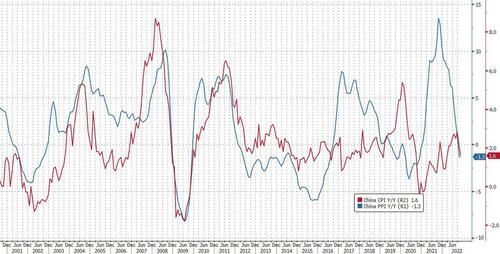Deflation, Rather Than Inflation, Is Currently The Main Risk Faced By China
By Stefan Koopman, Senior Macro Strategist of Rabobank
In stark contrast to last year, China is now having a positive impact on global inflation dynamics. Weak domestic demand, price declines in raw materials and the return to more normal supply- and logistics conditions, have resulted in China exporting deflation once again. This was evident in the country’s large trade surpluses, which were updated on Wednesday, and in this morning’s producer and consumer price inflation data.

Factory-gate prices fell 1.3% year-over-year in November, while consumer inflation eased to 1.6%. Core inflation remained unchanged at 0.6% year-over-year. Deflation, rather than inflation, is currently the main risk faced by China. The relaxation of the most stringent Covid-19 measures should support consumer demand, but it’s unlikely we will see latent demand being unleashed in the same way as we saw in cash-rich Europe and the United States. Moreover, the road to full reopening may still be difficult and bumpy when infections start surging.
China Premier Li Keqiang Says Key Problem Is Insufficient Demand
Stimmies on deck
— zerohedge (@zerohedge) December 9, 2022
More fundamentally, however, the conditions that have contributed to China’s rapid growth in exports relative to imports also explain its stagnant domestic consumption: both are a result of the great difficulty China has in rebalancing its economy from (non-productive) investment towards consumption and in addressing its significant legacy debt issues.
The main release of yesterday were US jobless claims, as there wasn’t much other data to go on. The figure of 230k indicates that new claims are moving sideways, suggesting that firing remains limited amid labor shortages and recruitment difficulties. However, continuing claims are now crawling upwards to 1,671k, a level almost in line with the 2019 average. This means that it is becoming harder and taking longer for unemployed individuals to find new jobs, something that has also been reflected in the JOLTS survey’s lower hiring rates. Overall, these numbers are more consistent with the gloomier household survey than the still upbeat establishment survey and indicative of a cooling labor market. Note also the 417% y/y increase in job cut announcements from the Challenger survey – up from 48% y/y in October!
It’s worth mentioning too that researchers from Indeed have updated the November data from the Indeed Wage Tracker. The figures are based on new job advertisements on their own platform and give an idea of the underlying wage dynamics. These show up with a lag in the official average wage data (e.g., as an analogy, think of these as a bath tub full of current wage contracts, with new contracts of hires coming out of the faucet and old contracts of fired/resigned workers leaving through the drain). The figures point at a rapid deceleration of advertised wage growth in the United States (6.5% y/y, from a peak of 9% in March 2022), and more muted deceleration in the United Kingdom (6.1% y/y, from 6.4% in June) and six Eurozone countries (5.1% y/y, from 5.2% in October). Slower posted wage growth suggests the risk of wage-price spiral remains limited.
Please note that Bas van Geffen and Elwin de Groot have published their preview for next week’s ECB meeting. The Global Daily is already highlighting this now, as they have downgraded their call from a 75 to a 50 basis point hike. The momentum for bigger steps seem to be fading after some softer inflation prints and after the Fed signalled it is going after a smaller hike. However, the size of next week’s rate hike is not yet a foregone conclusion. The timing of this potential downshift could give the impression that the ECB is not taking inflation seriously enough, and the exact balance of votes on the Governing Council remains unknown. As such, it is still possible that the ECB could surprise markets with a 75 basis point hike.
If the ECB does go for 50, Bas and Elwin would expect President Lagarde to stress that a smaller hike now does not affect the potential terminal rate. As a result, they have extended their policy expectations to include a final 25 basis point hike in April in order to maintain the forecast of a 3% terminal rate. Additionally, looming decisions on quantitative tightening may be cited as a factor offsetting the smaller increase in policy rates. This may start in early 2023, most likely in April. It is unlikely that the ECB will sell any assets, especially not in the early stages. A pace of €25-30 billion per month seems reasonable and achievable under these restrictions.
Loading…
[ad_2]
Source link


